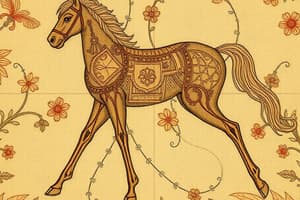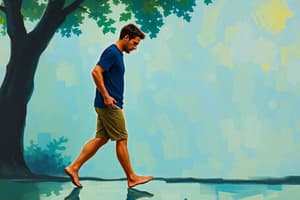Podcast
Questions and Answers
Define gait.
Define gait.
Bipedal locomotion as there is an alternating action between two lower extremities (one on the ground (stance, the other in (swing). It is a result of a series of rhythmic alternating movement of arms, legs and trunk that create forward movement of the body.
What percentage of the gait cycle is spent in the stance phase?
What percentage of the gait cycle is spent in the stance phase?
- 20%
- 40%
- 80%
- 60% (correct)
Which of the following is the first phase of the stance phase?
Which of the following is the first phase of the stance phase?
- Loading response
- Initial contact (correct)
- Terminal stance
- Midstance
When does the Loading Response phase occur in the Gait Cycle?
When does the Loading Response phase occur in the Gait Cycle?
When does the Midstance phase occur in the Gait Cycle?
When does the Midstance phase occur in the Gait Cycle?
When does the Terminal Stance phase occur in the Gait Cycle?
When does the Terminal Stance phase occur in the Gait Cycle?
When does the Preswing phase occur in the Gait Cycle?
When does the Preswing phase occur in the Gait Cycle?
When does the initial swing phase occur in the Gait Cycle?
When does the initial swing phase occur in the Gait Cycle?
In the initial contact phase the hip is [blank], the knee is [blank] and the ankle is [blank]
In the initial contact phase the hip is [blank], the knee is [blank] and the ankle is [blank]
During the loading response, body weight is transferred onto the forward limb and the knee is [blank] for shock absorption
During the loading response, body weight is transferred onto the forward limb and the knee is [blank] for shock absorption
In midstance, the limb advances over the stationary foot by [blank]
In midstance, the limb advances over the stationary foot by [blank]
During terminal stance, the heel [blank] and the limb advances over the forefoot rocker.
During terminal stance, the heel [blank] and the limb advances over the forefoot rocker.
During the pre-swing phase, the reference limb responds with increased ankle [blank], greater knee [blank] and loss of hip [blank]
During the pre-swing phase, the reference limb responds with increased ankle [blank], greater knee [blank] and loss of hip [blank]
In initial swing, the foot is lifted and the limb is advanced by hip [blank]and increased knee [blank]
In initial swing, the foot is lifted and the limb is advanced by hip [blank]and increased knee [blank]
Match the definition to 'Foot Angle'
Match the definition to 'Foot Angle'
Match the definition to 'Step Length'
Match the definition to 'Step Length'
Match the definition to 'Stride Width'
Match the definition to 'Stride Width'
Define 'Cadence'
Define 'Cadence'
Define 'Speed' with respect to gait
Define 'Speed' with respect to gait
Flashcards
Gait
Gait
Bipedal locomotion involving alternating movements of the lower extremities.
Gait Cycle
Gait Cycle
The period from heel contact of one foot to the next heel contact of the same foot.
Stance Phase
Stance Phase
The weight-bearing phase of the gait cycle, from initial contact to preswing (60% of the gait cycle).
Swing Phase
Swing Phase
Signup and view all the flashcards
Initial Contact (IC)
Initial Contact (IC)
Signup and view all the flashcards
Loading Response (LR)
Loading Response (LR)
Signup and view all the flashcards
Midstance (MSt)
Midstance (MSt)
Signup and view all the flashcards
Terminal Stance (TSt)
Terminal Stance (TSt)
Signup and view all the flashcards
Preswing (PS)
Preswing (PS)
Signup and view all the flashcards
Initial Swing (IS)
Initial Swing (IS)
Signup and view all the flashcards
Midswing (MSw)
Midswing (MSw)
Signup and view all the flashcards
Terminal Swing (TSw)
Terminal Swing (TSw)
Signup and view all the flashcards
Kinematics
Kinematics
Signup and view all the flashcards
Kinetics
Kinetics
Signup and view all the flashcards
Stride Length
Stride Length
Signup and view all the flashcards
Step Length
Step Length
Signup and view all the flashcards
Stride Width
Stride Width
Signup and view all the flashcards
Foot Angle
Foot Angle
Signup and view all the flashcards
Cadence
Cadence
Signup and view all the flashcards
Speed
Speed
Signup and view all the flashcards
Study Notes
- Gait analysis is the study of bipedal locomotion involving alternating actions between the lower extremities.
- The motion is a rhythmic series of arm, leg, and trunk movements that propel the body forward.
Gait Cycle
- The gait cycle is from the heel contact of one foot to the next heel contact of the same foot.
- The gait cycle comprises two phases: stance and swing.
- Stance phase: supporting/weight-bearing phase, from initial contact until preswing.
- Swing phase: foot leaves the ground until just before initial contact.
- Stance makes up 60% of the gait cycle.
- Swing makes up 40% of the gait cycle.
Stance Sub-Phases
- Initial Contact (IC): 2% of the gait cycle.
- Loading Response (LR): 2-10% of the gait cycle.
- Midstance (MSt): 10-30% of the gait cycle.
- Terminal Stance (TSt): 30-50% of the gait cycle.
- Preswing (PS): 50-60% of the gait cycle.
Swing Sub-Phases
- Initial Swing (IS): Acceleration phase, 60-73% of the gait cycle.
- Miswing (MSw): 73-87% of the gait cycle.
- Terminal Swing (TSw): Deceleration phase, 87-100% of the gait cycle.
Intervals of Gait
- Initial Double Limb Stance: 10%.
- Single Limb Stance: 40%.
- Terminal Double Limb Stance: 10%.
- Swing: 40%.
Functional Division of the Body
- During walking, the upper body acts as a passenger unit situated on a locomotor system.
- Locomotor functions = propulsion, stance stability, shock absorption, and energy conservation.
- Passenger unit components: head, neck, arms,trunk, and pelvis (HAT unit).
- The HAT unit's center of gravity is just anterior to the tenth thoracic vertebra (T10).
- In an average man (184 cm) this point is ~33 cm above the hip joint.
- The locomotor system = pelvis to both lower extremities with 11 joints involved.
Kinematics
- Distance and time variables, measurement of joint angles, determinants of gait.
Kinetics
- External and internal forces.
Distance Variable Definitions
- Step length = distance between heel strike of one foot and heel strike of the opposite foot.
- Stride length = distance covered by the same foot from one heel strike to the next heel strike of the same foot.
- Stride width = lateral distance between midpoints of the feet during walking.
- Foot angle = angle between the foot's longitudinal axis and the direction of walking.
Time Variable Definitions
- Step: movement from one foot strike to the next.
- Stride: one full gait cycle (two steps).
- Stance = the phase when the foot is in contact with the ground.
- Swing = when the foot is off the ground.
- Single limb support: when only one foot is on the ground.
- Double limb support: when both feet are in contact with the ground.
- Cadence: the number of steps taken per minute = ~113 steps/min.
- Speed determined by distance covered per unit of time during walking/running = ~1.2 m/sec or ~82 m/min.
Studying That Suits You
Use AI to generate personalized quizzes and flashcards to suit your learning preferences.




